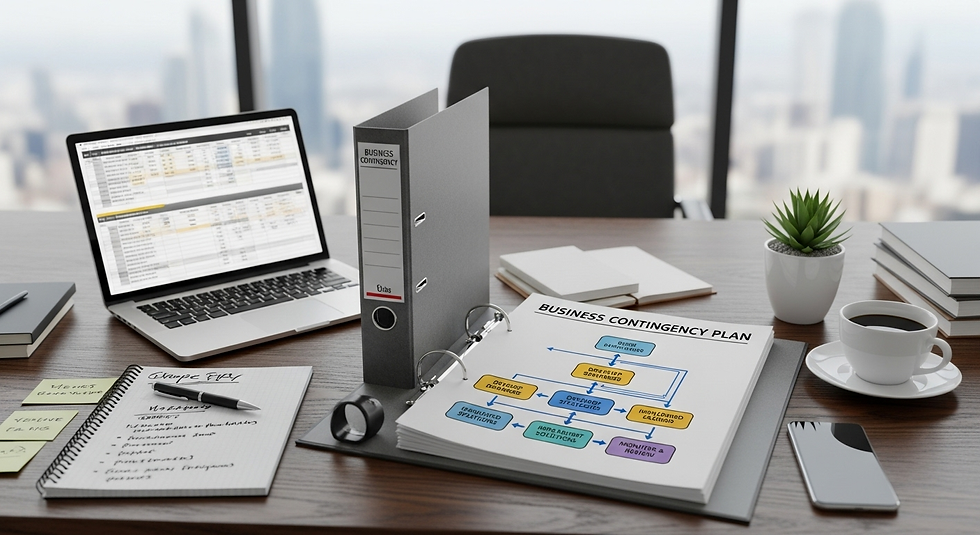Why Every Business Should Have an Emergency Response Plan in Place?
- seo coder
- Sep 6, 2024
- 4 min read
Updated: Dec 5, 2024
Unexpected incidents can happen at any time. How does your business handle a natural disaster, medical emergency, or other crises?
Is your company prepared for the worst-case scenario strikes? That is why emergency preparedness and emergency response planning are critical for many industries.
Are you seeking a disaster planning consultant to safeguard your business against unforeseen disruptions? Explore how Business Contingency Group can devise tailored contingency solutions to ensure continuous operations. We offer businesses expertise and training on demonstrating a high level of leadership during the event of an emergency.
What is an Emergency Preparedness Plan?
An emergency preparedness plan is a comprehensive strategy to lessen the impact of unexpected events or disasters. It outlines the necessary steps and actions to be taken to protect individuals, communities, and organizations during emergencies. This post aims to provide a clear understanding of what an emergency preparedness plan entails and why it is crucial to have one in place.
Imagine a fire breaks out in a building. An effective emergency plan should include clear evacuation routes, regular fire drills, and meeting points outside the building. This process also helps you account for everyone on site and do roll calls. This helps everyone act quickly and calmly, reducing the risk of injury or worse.
The possible risks of not having an emergency preparedness plan
Every business can face unexpected problems no matter how big or small it is. These problems can be natural disasters medical emergencies or cyberattacks. If there is no emergency plan these incidents can cause serious damage to your business. Here are five big risks that your business might face without an emergency preparedness plan.
1. Business May Stop Working
When a disaster happens without an emergency plan, your business might have to stop working for a long time. This could make you lose money, your customers might lose trust, and your business could fall behind others. Without clear steps to follow, your business could take much longer to get back on its feet. This would make the financial loss even worse.
2. May Suffer Financial Loss
Emergencies can cost your business a lot of money. You might have to pay for fixing damages paying legal fees or even getting fines if you did not follow safety rules. A good emergency plan can help reduce these money problems because it will help your business respond fast and in the right way.
3. Harm to People
During an emergency the safety of the employees and customers is the most important thing. Without a plan people may get confused and this could put their lives in danger. A good plan makes sure everyone knows what to do like how to leave the building or where to find shelter and how to get help quickly.
4. Bad Reputation
If your business does not respond well to a crisis, it could hurt your reputation. Customers, partners, and others expect you to be ready for any problems. If you do not handle a disaster well, people could lose trust in your business, and this can lead to bad publicity that is hard to fix.
5. Legal Problems
Your business might face legal trouble if it does not meet safety standards without an emergency plan. You could get sued or fined if people get hurt or if there is damage that could have been avoided with better planning. A proper emergency plan can help you avoid these problems.
Must Elements of Your Emergency Preparedness Plan
Every business needs an emergency preparedness plan to protect employees, customers, and the business. Here are the key things that every emergency preparedness plan must include.
1. Identify Risks
The first step is to figure out the risks your business might face. This means looking at possible threats like natural disasters such as floods, fires, or earthquakes. It could also include other emergencies like medical issues, power outages, or cyberattacks. Understanding the most likely risks will help you prepare better.
2. Clear Emergency Steps
Your plan should have easy-to-follow steps for different types of emergencies. These steps should explain how to evacuate the building, where people should go to stay safe, and how to report the situation. The plan should also cover first aid and medical help if needed. Make sure everyone knows these steps so they can act quickly when needed.
3. Assign Roles
It is important to assign clear roles during an emergency. People need to know who is in charge and who will be responsible for helping others. This includes team leaders, emergency coordinators, and people trained in first aid. Assigning roles helps make sure that everyone knows what to do and prevents confusion.
4. Communication Plan
A good emergency plan includes a way to communicate with employees, customers, and emergency services. Your plan should explain how to send out messages, whether through text, email, or announcements. It is also important to have a backup way to communicate if the main method does not work.
5. Training and Practice
Having a plan is only useful if people know how to use it. That is why training and practice drills are important. Employees need to practice evacuation routes and how to use emergency tools. Regular training makes sure that everyone knows what to do when an emergency happens.
Conclusion:
Your company must be prepared for emergencies to stay safe and effective. Reviewing and revising your emergency plans and training your employees will make your building more secure.
Do you want to learn more about how BCG can help you to know that your employees are safe when working? Call us for our solution to support your emergency planning for employees.




Comments